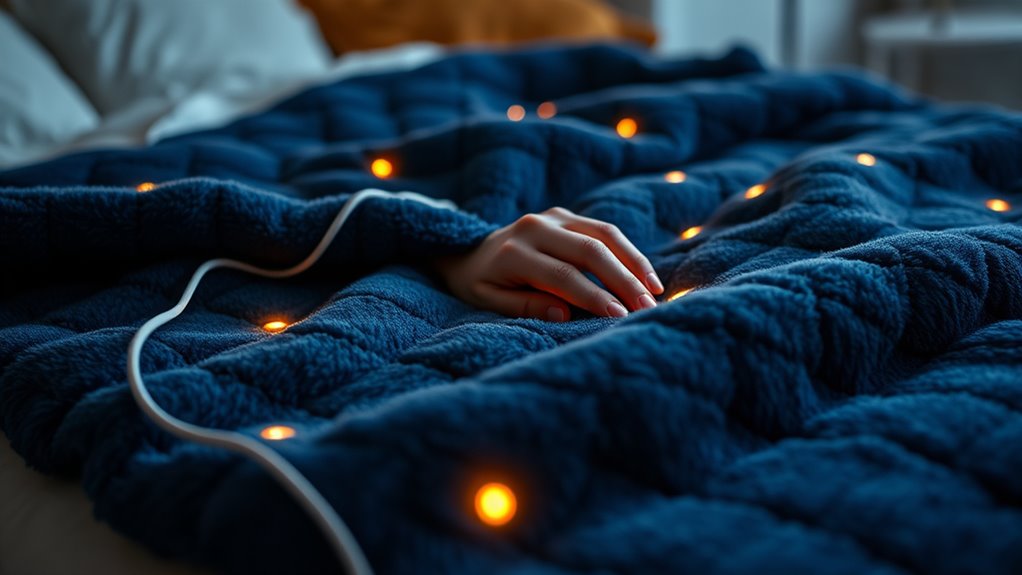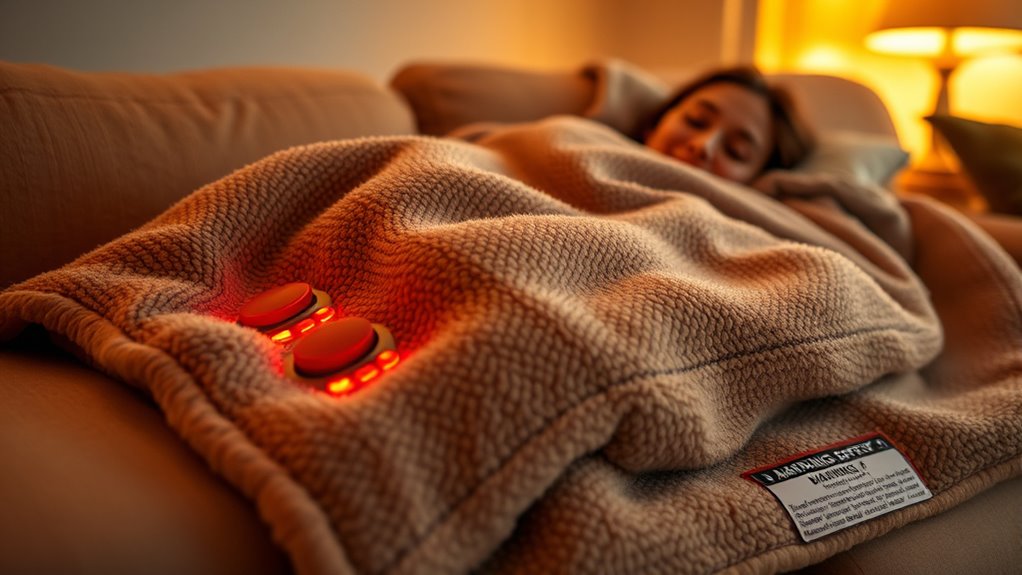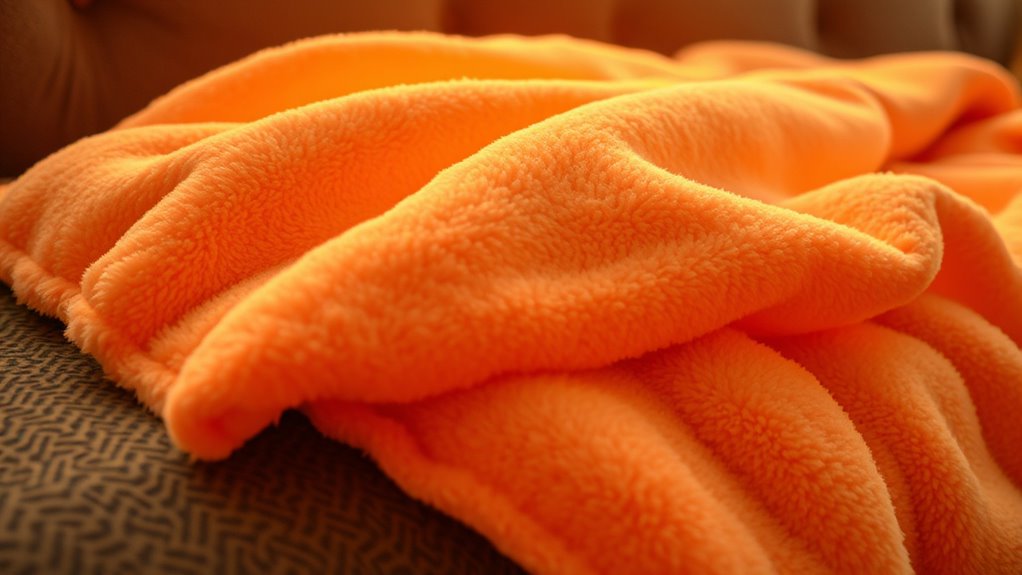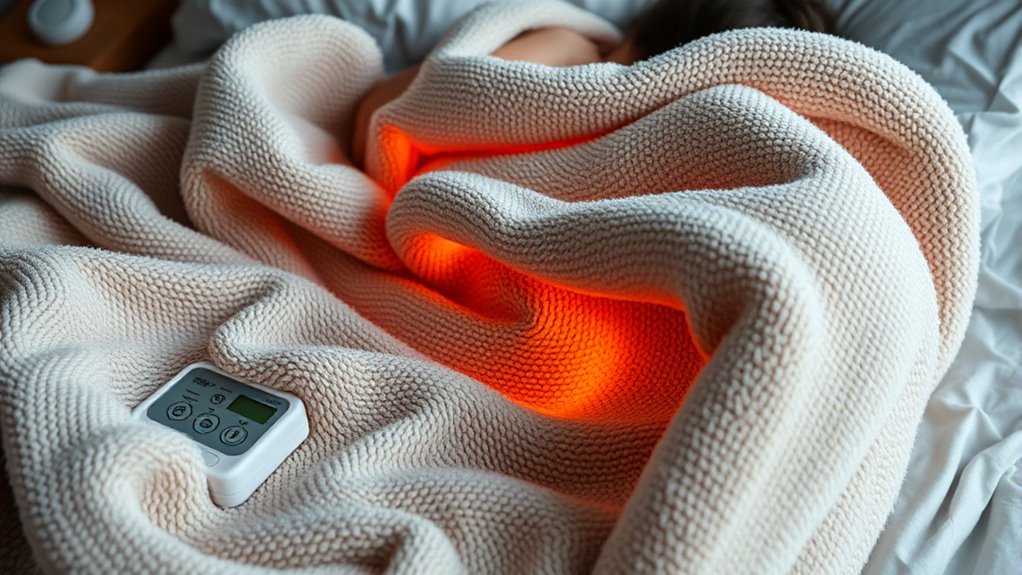Heated blankets can bring cozy warmth and comfort, making cold nights more pleasant. However, safety concerns like faulty wiring, overheating, or damage should not be overlooked. Regular inspections, proper usage, and choosing models with safety certifications help minimize risks. There are also safer alternatives like thermal layers or water-based systems. To enjoy warmth comfortably without worry, understanding these safety tips and features is key—if you continue, you’ll discover how to stay safe while staying cozy.
Key Takeaways
- Electric blankets provide quick, customizable warmth that enhances comfort and sleep quality during cold nights.
- Regular inspection, proper usage, and following safety guidelines minimize risks like overheating and electrical hazards.
- Choosing certified models with safety features such as automatic shut-off ensures safer use and reduces fire risks.
- Alternative cozy options like thermal pajamas or water-based systems eliminate electrical hazards and EMF concerns.
- Replacing blankets every 3-10 years and proper storage maintain safety, durability, and overall happiness with warm sleep experiences.
How Electric Blankets Provide Comfort and Their Popularity

Electric blankets quickly warm your bed, making them a popular choice for cozy comfort during cold nights. These heated blankets offer adjustable temperature control, so you can customize your warmth for maximum comfort. Modern electric blankets feature safety enhancements like automatic shut-off, ensuring peace of mind while providing reliable warmth. Consumers favor these blankets because they combine comfort and safety, helping to reduce household heating costs with energy-efficient heating. The popularity of electric blankets continues to grow, driven by their ability to deliver consistent warmth during cold seasons and improve sleep quality by maintaining a steady body temperature all night. With advanced controls and certifications, today’s electric blankets are designed to meet safety standards while providing cozy comfort when you need it most. Additionally, incorporating safety features during use can enhance the overall comfort and safety experience, especially with innovations in overheat protection. Proper maintenance and following safety guidelines further ensure a safe and comfortable experience with electric blankets.
Understanding the Safety Risks Associated With Heated Blankets

While heated blankets offer cozy warmth and comfort, they also carry safety risks you need to be aware of. Faulty or damaged wires in electric blankets can lead to overheating, increasing the fire hazard, especially in older models over ten years. Improper use, like folding or bunching the blanket, can damage internal wiring and cause electrical faults. Overheating can also result in burns, particularly in children and seniors with reduced sensation. Electromagnetic fields (EMFs) emitted by electric blankets raise health concerns, though research remains inconclusive. Safety features such as automatic shut-off and precise temperature controls help reduce risks, but without proper use and adherence to safety standards, the dangers remain. Being aware of these risks ensures safer enjoyment of your heated blanket. Additionally, understanding water safety is important when considering the longevity and maintenance of electric blankets, especially in humid environments. Incorporating smart safety features like automatic shut-off can further mitigate potential hazards, and choosing models with UL safety certification can provide added peace of mind. Regularly inspecting your electric blanket’s wiring for signs of wear can help prevent potential electrical faults and ensure safe usage. Moreover, following manufacturer instructions for proper storage and maintenance can extend the lifespan of your heated blanket and reduce safety risks.
Signs of Wear and Damage That Could Compromise Safety

Recognizing signs of wear and damage is essential for ensuring your heated blanket remains safe to use. Look for visible damage like holes, tears, or melted spots that suggest fabric deterioration. Worn fabric, especially around seams or control areas, can expose wires or reduce insulation, increasing safety hazards. Check for scorch marks or unusual discoloration, which may indicate overheating or internal damage. Exposed wires or damaged insulation can lead to electrical faults, risking fire or shock. Crimped, twisted, or pinched cords compromise safety by damaging insulation and increasing electrical fault risk. Any signs of damage—such as frayed wires, burning smells, or visible damage—should be addressed immediately to prevent potential hazards. Additionally, staying informed about electrical safety standards and advances can help you better understand the importance of maintaining electrical safety standards. Regularly inspecting your heated blanket for wear and tear can help detect issues early, preventing accidents. For added safety, consider testing your heated blanket periodically with a ground fault circuit interrupter (GFCI) to prevent electrical shock. Being aware of product recalls related to heated blankets can also be crucial for safety. Staying vigilant helps protect you from dangers linked to compromised heated blanket safety.
Proper Usage Tips to Minimize Fire and Overheating Hazards

To keep your heated blanket safe, you should regularly check wires and cords for damage or fraying. Always follow the manufacturer’s instructions for safe use and heating duration, and store the blanket properly when not in use. Taking these steps can markedly reduce the risk of fire and overheating. Additionally, avoiding the use of damaged or worn-out filters can help prevent potential hazards associated with overheating or electrical issues.
Regularly Inspect Wires and Cords
Regularly examining the wires and cords of your electric blanket is essential for safe operation. Look for damage like fraying, cracks, or exposed wiring, as these issues can lead to electrical faults or overheating. If you notice any damage, replace the cords immediately to prevent fire hazards. When unplugging, always grasp the plug firmly instead of yanking on the cords, which can cause internal wire damage. Proper storage, such as gently rolling the blanket, reduces stress on the wiring and prevents short circuits. Conduct visual and functional checks before each use to ensure all wires are intact and heating elements distribute heat evenly. Regular inspection keeps your blanket safe, reducing risks associated with damaged wires and ensuring cozy comfort without safety concerns. Recognizing soulmate angel numbers during these checks can also serve as a reminder to stay open to love and positive transformations.
Use Proper Storage Practices
Proper storage is essential for keeping your electric blanket safe and in good condition. To do this, gently roll the blanket instead of folding it to prevent damage to the wires and reduce fire risk. Make sure the cords are untangled and kept away from heavy objects, furniture, or areas where they could be pinched or frayed. Store the blanket in a dry, cool, and well-ventilated space, avoiding moisture and extreme temperatures that could cause damage. Before storing, inspect the blanket for signs of wear, such as frayed wires or fabric damage. Always disconnect the electrical components following the manufacturer’s instructions and ensure the blanket is clean and dry. Proper storage practices help prolong your blanket’s lifespan and minimize safety hazards. Regularly checking your blanket for damage or wear and ensuring proper electrical connection] can help prevent potential hazards and ensure safe use over time.
Follow Manufacturer Safety Instructions
Following the manufacturer’s safety instructions is essential for preventing fire and overheating risks when using your electric blanket. Always adhere to proper use guidelines for turning on, adjusting, and turning off your blanket to ensure electric blanket safety. Regular inspection is key—check the cord, plug, and control unit for damage signs like fraying or wear, and replace the blanket if needed. Avoid folding, bunching, or creasing the blanket during use, as this can damage internal wiring and cause electrical faults or fires. When not in use, unplug the blanket and store it properly, either flat or rolled, to maintain safety features and prevent internal wire damage. Implementing automation technologies can also help monitor your blanket’s condition remotely, alerting you to potential issues before they become hazards. Following these safety tips minimizes overheating prevention issues and reduces your fire risk.
Potential Health Concerns Related to EMF Exposure and Overheating

You should be aware that electric blankets emit small amounts of EMFs, which some studies associate with health risks, though conclusive proof is lacking. Overheating can also cause burns or discomfort, especially for vulnerable groups like children and pregnant women. Using safety features and choosing certified products can help minimize these potential concerns.
EMF Exposure Risks
Are EMF exposure risks from electric blankets a genuine health concern? Electric blankets emit electromagnetic fields, or EMF emissions, which are classified as low-level radiation and fall under extremely low frequency (ELF) electromagnetic fields. Current safety concerns suggest that typical EMF exposure from these blankets doesn’t pose significant health risks, including cancer risk or reproductive issues. The World Health Organization states there’s no confirmed link between ELF EMF exposure and adverse health effects, even during pregnancy. Although some studies hint at biological effects from prolonged high-intensity EMF exposure, normal electric blanket safety levels are well below those thresholds. To reduce EMF exposure further, you can enable airplane mode or keep a safe distance during use, ensuring peace of mind.
Overheating and Burns
While electric blankets are generally safe when used properly, overheating remains a potential health concern that shouldn’t be overlooked. Excessive heat can cause burns, especially for children and older adults with reduced sensation. Prolonged use or high temperature settings increase the risk of skin burns and heat injuries. Damage to internal wiring, frayed cords, or faulty controls can lead to localized overheating, creating a fire hazard. Modern electric blankets often include automatic shut-off features to aid in overheating prevention. To ensure electric blanket safety, follow safety guidelines such as monitoring temperature control and avoiding prolonged use on high settings. Proper use minimizes heat injury risks and keeps you cozy without compromising safety.
Safer Alternatives for Warmth and Relaxation During Sleep

To enjoy warmth and relaxation during sleep safely, exploring alternatives to traditional electric blankets is essential. Insulated bedding, such as thermal pajamas and layering blankets, offers natural insulation and customizable comfort without fire hazards or EMF exposure. Water-based heating systems like the Chilipad circulate temperature-controlled water for even warmth, eliminating the risks associated with electrical wires directly on your body. Using safety tips, like wearing socks or adding extra blankets, helps maintain body heat without electrical devices. These alternative warmth options improve sleep comfort while reducing potential dangers, making them ideal for vulnerable populations. Non-electric heating methods provide cozy, safe relaxation, allowing you to enjoy restful sleep without the safety concerns linked to traditional electric blankets.
Features to Look for in Safe and Certified Electric Blankets

Choosing a safe electric blanket starts with paying attention to key features that guarantee reliable performance and your safety. Look for models that meet recognized safety standards like UL, ETL, or CSA certification, ensuring they comply with electrical safety requirements. Select blankets equipped with temperature controls, overheat protection, and automatic shut-off features to prevent burns and fire hazards. Prioritize those with durable wiring integrity and insulation quality, which reduce the risk of electrical faults. Check for clear safety labels and detailed manufacturer guidelines that provide essential use instructions. Regular damage inspection is crucial—look for signs of wear, frayed wires, or deterioration. Always replace blankets that lack proper certification or show damage to maintain safety and peace of mind.
Best Practices for Maintaining and Replacing Your Heated Blanket

Regular maintenance is essential to guarantee your heated blanket remains safe and functional. To keep it in top shape, follow these best practices:
- Conduct regular safety inspections for damage signs like frayed wires or scorch marks, and replace electric blankets showing damage.
- Follow cleaning guidelines by unplugging the blanket and avoiding folding or bunching to prevent internal wire damage.
- Adhere to the replacement timeline—consider replacing your electric blanket every 3 to 10 years to avoid electrical faults and fire risks.
- Store your heated blanket properly by rolling it gently and keeping it in a cool, dry place away from sunlight and moisture.
Always watch for malfunction indicators like inconsistent heating, unusual smells, or visible damage, and prioritize safety precautions during maintenance.
Frequently Asked Questions
What Is the Most Reliable Heated Blanket?
When you’re looking for the most reliable heated blanket, focus on brands like Sunbeam, Biddeford, and Woolly Mammoth, which meet high safety standards. Choose models with automatic shut-off, adjustable temperature controls, and UL certification. Regularly inspect your blanket for damage and replace it every 3-5 years to guarantee safety and durability. By selecting a trusted brand with safety features, you can enjoy cozy warmth with peace of mind.
Are There Health Issues With Electric Blankets?
Imagine your electric blanket as a warm guardian—offering comfort but with hidden risks. You might worry about health issues, but current evidence shows no conclusive links to cancer. EMFs are deemed safe, especially with proper maintenance and controls. Still, if you have health conditions or are pregnant, it’s wise to consult your doctor. Your cozy shield can be safe when used thoughtfully, balancing warmth with caution.
What Are the Chances of an Electric Blanket Catching Fire?
The chances of an electric blanket catching fire depend largely on its age and condition. If you’re using an older model, especially over 10 years, the risk increases considerably. Damaged wiring or frayed cords also raise the odds. However, modern blankets with safety features like auto shut-off dramatically lower the risk. To stay safe, regularly inspect and replace worn blankets, and avoid using damaged or outdated models.
How Do I Know if My Electric Blanket Is Safe?
To know if your electric blanket is safe, first check for safety certifications like UL or ETL. Regularly inspect it for frayed wires, scorch marks, or strange smells. Make sure it has automatic shut-off and proper controls. If it malfunctions, looks damaged, or doesn’t turn off properly, stop using it immediately. Keep it clean and stored correctly to prevent internal damage. Prioritize safety to enjoy cozy warmth without worries.
Conclusion
While a heated blanket can feel like a cozy hug from a cloud, don’t let safety slip through the cracks. Regularly check for wear, follow proper usage tips, and choose certified products to keep your warmth safe and sound. Remember, neglecting safety could turn your comfy haven into a fire hazard faster than you can say “hot mess.” Stay vigilant, stay warm, and enjoy your blanket’s comforting embrace without risking a heating disaster!








